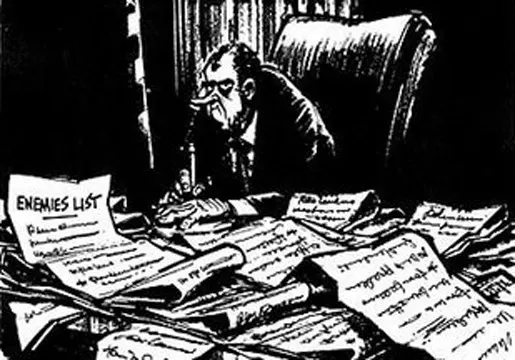The “enemies list” was a tally of political opponents kept by the Nixon administration.
The phrase is now used as shorthand to refer to suspected abuses of power in any administration.
Origin of “Enemies List”
In 1973, former White House aide John Dean told the Senate that President Nixon kept a list of his political opponents.
The so-called “opponents list” had been compiled for Nixon’s trusted aide, Charles Colson. It featured the names of public figures who were thought to pose a threat to the Nixon administration.
The list included notes about any known weaknesses of the “enemies,” and also suggested finding a way to “use the available federal machinery to screw our political enemies.”
The Nixon White House also set up a “plumbers” unit to uncover enemies within the administration.
Dean revealed the list’s existence during a hearing of the Watergate Committee. On the same day, the CBS journalist Daniel Schorr managed to get a copy of the list, which he began reading, out loud and on air, to his audience. (A second, longer version of the list appeared later that year.)
“I got to No. 17, and I said, ‘No. 17, Daniel Schorr, a real media enemy,’ ” Schorr told The Hill, decades later.
“I almost collapsed on the air. I had never read it before, never seen it before, never expected it. But I continued and said, ‘No. 18, Paul Newman. No. 19, Mary McGrory [the Pulitzer Prize-winning reporter for The Washington Post].’ It was such a distinguished list,” he said, joking that the notoriety of the list made him more popular. “My lecture fees went up.”
Schorr wasn’t the only one who was proud to be on Nixon’s list. The Village Voice ran a tongue in cheek piece that year titled “The Shame of Being Left Off Nixon’s Enemies List.” The article speculated about what might happen to leftist commentators, activists, and others who prided themselves on being “anti-establishment,” if those people turned out not to be on Nixon’s all-important list:
What newspaper is going to shell out hard cash for a columnist whose opinions are so tame that even the White House doesn’t consider him dangerous? Poor Nick Von Hoffman. Darling of the New Left, intimate of numerous Democrats, defender of the Chicago Seven, how does he face his readers, knowing that Nixon, Haldeman, Ehrlichman, and Dean all considered Max Lerner a greater threat to their empire? And Jimmy Breslin. For years he and Pete Hamill have fought tooth and nail to see which one could say the most outrageous things about the Nixon regime. How can Breslin even manage to drag his poor broken body out of bed in the morning now that Hamill has administered the tour de force?
A few decades later, some journalists and pundits began making comparisons between Nixon’s enemies list and the Trump administration. In 2018, the Trump White House announced that it had stripped the security clearance from former CIA director John Brennan and that it was considering doing the same to others.
Mike Mullen, a former chair of the Joint Chiefs of Staff, told Fox News that this meant the president was “creating a list of political enemies.”

Use of “Enemies List” in a sentence
- The revelation that the administration maintained an “enemies list” of political opponents and critics raised serious concerns about abuse of power and an erosion of democratic norms.
- The concept of an “enemies list” became infamous during the Nixon era, symbolizing a vindictive and paranoid style of political management that sought to retaliate against perceived adversaries.
- Historians often reference the “enemies list” as a cautionary tale of how political leaders can become ensnared in divisive and retributive tactics, undermining the principles of transparency and accountability essential for democratic governance.